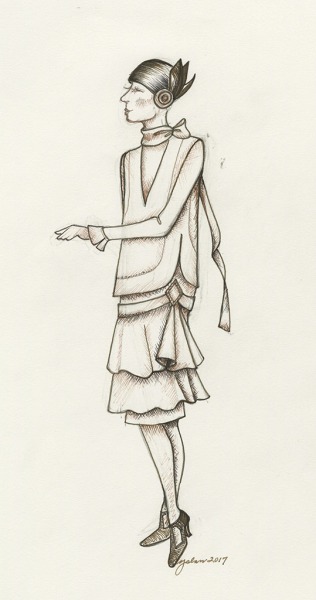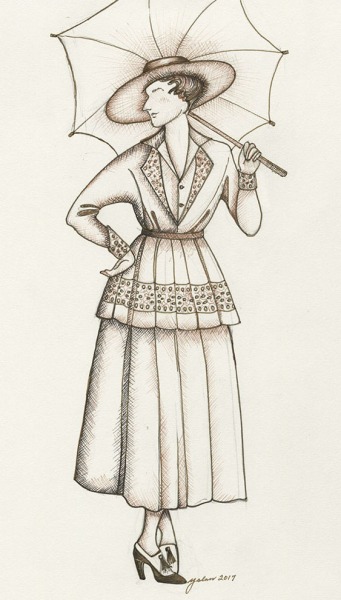1904-1924
From S-Bend Corsets to Suffragette City
Fashion, as observed and worn by the women who fought to achieve suffrage in the 20th century, evolved rapidly and dramatically. In just 20 years the ubiquitous corset gave way to little support or padding. Hems that formerly swept the floor rose, revealing first ankles, then knees. A low, matronly bosom evolved to a pert, somewhat androgynous bust. Waist-length hair was chopped to the chin. Areas of the female body that had long been concealed through socially-enforced agreements became visible.
The fashion silhouette that was associated with the American financiers’ daughters who married well abroad morphed into upper-body freedom but hobbled steps. World War I took America’s idealistic young men to foreign soil. Women necessarily replaced them in the performance of many practical tasks. For a time, women’s clothing celebrated the sacrifice of sons with masculine and military detailing such as buttons, pockets, and epaulets. More lasting and noteworthy was the rising hemline that would not fall to rake the floorboards ever again.
The middle of the first decade of the 20th century found women’s torsos encased in an S-bend corset. The Victorian corset had trimmed the waist and allowed the bust and abdomen to remain lush and full. The rigid busk in the center front of the S-bend corset forced a straight line from bust to hip. The corset forced the hips back and arched the back.
The bend was further emphasized by the “pouter pigeon” front of the bodice and the close cut of the skirt over the hips. The hemline was often two or more inches longer than the floor. Much like the five-inch “limo heels” we see in our day and age, this silhouette appears to better serve inactivity than movement.
The French designer Paul Poiret is often credited with creating fashion that discarded the boned corset in favor of styles that fell more naturally from the shoulders. Remarkably, the shift in silhouette led to another fashion curiosity: the hobble skirt.
The hemline of the hobble skirt was so narrow as to impede the stride of the wearer. According to history, some women went so far as to wear a fetter that looped over each leg with a short band in between—not unlike a horse’s hobble—in order to keep steps small so as not to tear the fabric of the dress. As the silhouette grew in popularity, construction methods including pleating allowed for greater movement at the ankles while maintaining the narrowed appearance of the garment.
America's engagement in World War I had a significant impact on fashion, and not just because clothing adopted details that were characteristic of military wear. The excited flood of young men into the armed services left necessary home-front duties unattended. Women filled positions that required functional clothing. Hems rose to reveal shod or booted feet and a bit of the leg.
By the time the 19th Amendment to the U.S. Constitution was ratified on August 18, 1920, the uncompromising corset and the checked stride, not to mention the Victorian morals they represented, had all but collapsed under the pressure of change wrought by globalized experiences.
Women's hemlines rose to the knee and flapper culture ushered in a gender-bending silhouette that scandalized those who clung to values of the past. Smoking, suntans, garters, and flasks were the necessary accessories for the new woman.
F. Scott Fitzgerald’s marvelous short story “Bernice Bobs Her Hair,” first published in the Saturday Evening Post in 1920, provides context for another earth-shattering change made by women who saw themselves as more than merely dolls or visual representations of their husbands’ wealth. Long hair was more than a glory, it was a condition whose maintenance could be considerably time consuming.
The lopping off of waist-length or longer hair in favor a quickly-dried, height-of-fashion, chin-length bob said a great deal about the never-going-back transformation that was long sought by those who valued suffrage. The barber’s shears removed the weight of the hair, and the haircut itself can be seen as a metaphor for the diminishing weight of traditional 19th-century expectations.
Yslan Hicks, interim chair and associate professor in the Department of Theatre Arts and Dance at UA Little Rock, has extensive professional design credits, including productions at the Lincoln Center Institute, the Goodman Theatre Studio, Portland Center Stage, the Old Globe Arena, Williamstown Theater Festival, Arkansas Repertory Theatre, and Lifeline Theatre in Chicago. Her university of Tulsa and Tulane University. Recent speaking engagements with the Central Arkansas Library System include a three-part series on the fashion of Downtown Abbey and a talk on memorable 19th-to21st-century wedding dresses. In 2012, Yslan was recognized by the Arkansas Women's Foundation with a Designing Woman award.




